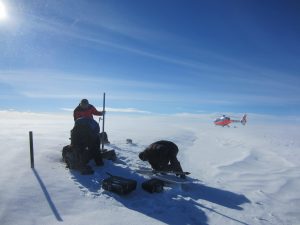Tom Cowton
Bio:
I couldn’t say exactly when I became interested in glaciers, but growing up amidst the glaciated scenery of the Lake District likely had something to do with it. A Geography degree at the University of Cambridge gave me a taste of research, undertaking a dissertation project on glaciated landscapes in Spain which led to my first publication. I didn’t fully take the plunge into the world of glaciology though until I signed up for a PhD project at the University of Edinburgh, attracted by the promise of exciting research and six months fieldwork in Greenland. After seven years of PhD and postdoctoral research, I started as a lecturer at the University of St Andrews in September 2016.

Installing GPS units to monitor the movement of the Greenland Ice Sheet
Research interests:
My current research is focussed on the interaction between the Greenland Ice Sheet and the surrounding ocean. In particular, I’ve been using an ocean circulation model to study the passage of (relatively!) warm waters from the North Atlantic along fjords to meet with marine-terminating glaciers, where they are a significant cause of melting. There’s more information on this work on the Research pages.
In 2013, I completed my PhD at the University of Edinburgh on The hydrology of a land-terminating Greenlandic outlet glacier. This work was undertaken as part of a larger NERC funded investigation into the influence of meltwater runoff on the dynamics of the Greenland Ice Sheet. You can read more about that project here.
My first publication was focussed on glacial geomorphology, using relic landforms and sediments to reconstruct a former ice cap in the Sanabria mountains in of northwest Spain. This proved to be one of the largest relic ice caps south of the Pyrenees, providing an insight into the climate of this region during the Last Glacial Maximum.
